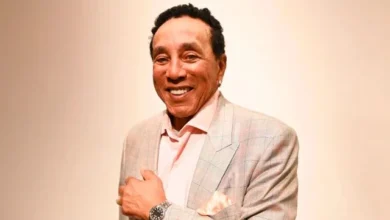
Paula Abdul Ethnicity and Parents Nationality
Paula Abdul, an iconic figure in the world of entertainment, is best known for her accomplishments as a dancer, singer, choreographer, and television personality. Her journey to fame began in the 1980s and continues to inspire countless individuals in the entertainment industry. However, many fans are curious about her ethnicity and the cultural background of her parents. Understanding the roots of Paula Abdul’s heritage offers a deeper insight into her identity and the influence her background may have had on her career.
Paula Abdul Ethnicity and Cultural Background
| Category | Musicians |
|---|---|
| Full Name | Paula Abdul |
| Birthdate | June 19, 1962 |
| Birthplace | San Fernando, California, United States. |
| Ethnicity | Syrian Jewish and Ashkenazi Jewish descent. |
| Father Ethnicity | Syrian Jewish descent. |
| Mother Ethnicity | Ashkenazi Jewish decent. |
Paula Abdul, an influential figure in the entertainment industry, was born on June 19, 1962, in San Fernando, California. Her upbringing and family roots played a significant role in shaping both her personal identity and artistic career. Paula’s heritage reflects a unique blend of Middle Eastern and Jewish ancestry, which has provided her with a rich cultural background. In this section, we will explore her ethnic mix, the cultural influences from both sides of her family, and how this fusion of backgrounds contributed to her individuality and career.
Paula Abdul Mixed Heritage
Paula Abdul’s ethnicity is marked by a unique combination of Syrian Jewish and Ashkenazi Jewish backgrounds. This fusion of Middle Eastern and Eastern European Jewish roots creates a rich, diverse, and multifaceted cultural identity, reflecting both the traditions of her Syrian heritage and the historical influences of Eastern European Jewish culture.
Paula Abdul Syrian Jewish Descent Father Side
Paula’s father, Harry Abdul, hails from a Syrian Jewish background. Syrian Jews have a long history in the Middle East, particularly in Syria, where their presence dates back for centuries. Historically, Syrian Jews have faced challenges, including political instability and persecution, which led many families to emigrate to countries like the United States in search of safety and better opportunities. The Syrian Jewish community is famous for its distinct traditions, customs, and contributions to Jewish culture, particularly in areas such as music, literature, and religious practices.
Growing up with a Syrian Jewish father, Paula was exposed to the rich cultural heritage of this community. While Syrian Jews are a relatively small minority within the broader Jewish population, they have a deep connection to their history and religious practices, which often influenced Paula’s upbringing and cultural perspective.
Paula Abdul Ashkenazi Jewish Descent Mother Side
Paula’s mother, Lorraine Rykiss, has Ashkenazi Jewish roots, which trace back to Eastern Europe. Ashkenazi Jews, one of the largest Jewish subgroups, are primarily of German, Polish, Russian, and other Central and Eastern European origin. Historically, Ashkenazi Jews faced significant challenges, including persecution, migration, and the horrors of the Holocaust, leading to a widespread diaspora.
Lorraine’s Eastern European Jewish background means Paula also inherited cultural traditions unique to this group, such as distinct Yiddish expressions, Ashkenazi Jewish culinary traditions, and an affinity for intellectual pursuits. The influence of this heritage can be seen in many aspects of Paula’s life, including her connection to Jewish values, family, and community.
Paula Abdul Cultural Traditions and Artistic Expression
Growing up in a household that celebrated a blend of Middle Eastern and Eastern European Jewish cultures, Paula Abdul was exposed to a variety of traditions and practices. This multicultural environment had a profound impact on her artistic development and creative expression.
Paula Abdul Influence on Dance and Music
Paula has often spoken about how her diverse heritage influenced her love for dance and music. From a young age, she was encouraged to embrace her cultural roots while also exploring different artistic avenues. Her father’s Middle Eastern background likely exposed her to the rhythms and styles of dance found in the Arab world, while her mother’s Ashkenazi Jewish heritage may have fostered an appreciation for theatricality and expression through performance.
This combination of influences helped Paula develop a unique style, both as a dancer and a choreographer. Her ability to blend various artistic elements from different cultures allowed her to create distinct and memorable performances, making her a sought-after choreographer for music videos and live performances during the height of her career. Her choreography often incorporated fluid movements, rhythmic precision, and a wide array of musical genres, which likely stemmed from her exposure to diverse musical traditions within her family.
Paula Abdul Layer of Complexity in Her Public Persona
Paula’s mixed ethnic background is an essential part of her identity, both in her personal life and professional career. It adds a layer of complexity to her public persona, as she is not easily defined by any single cultural or ethnic group. Her blend of Middle Eastern and Jewish heritage has allowed her to relate to a broad audience, transcending cultural boundaries. This unique combination has helped her become a relatable figure to fans from various backgrounds, particularly those who share similar ethnic roots or who appreciate diversity in the arts.
Throughout her career, Paula Abdul has embraced her cultural heritage, often acknowledging the role that her background has played in shaping who she is. By doing so, she has inspired many of her fans, particularly those from diverse backgrounds, to celebrate their own mixed heritages and express their individuality.
The Significance of Paula Abdul Ethnic Background
Paula Abdul’s ethnic mix is not just an interesting aspect of her identity; it has played a significant role in her artistic journey. Growing up in a family that valued cultural traditions and encouraged creativity, Paula learned to embrace her heritage, which ultimately influenced her approach to dance, music, and performance.
Her Syrian Jewish and Ashkenazi Jewish background not only contributed to her distinctive artistic style but also helped her build a career that defies stereotypes and celebrates the beauty of cultural diversity. Paula’s ability to blend different cultural influences into her work has made her a trailblazer in the entertainment industry, inspiring future generations of artists to celebrate their heritage while pushing creative boundaries.
Paula Abdul Siblings and Family Life
Paula Abdul, widely recognized for her multi-faceted career as a dancer, singer, choreographer, and television personality, grew up in a supportive family that played a key role in shaping her into the star she became. While much of her public life has centered around her own accomplishments, less is known about her siblings. In this article, we’ll delve into what is known about Paula Abdul’s siblings and her family life.
Paula Abdul Siblings Overview
Paula Abdul is the eldest of three children in her family. She has two younger brothers, named Walt Abdul and Guy Abdul. While Paula has been a very public figure, her brothers have remained largely out of the spotlight, keeping a more private and low-key life compared to their famous sister.
Paula Abdul Brother Walt Abdul
Walt Abdul is Paula’s older brother. He has generally kept a very low profile and has not sought the same kind of fame that his sister has. There is little public information available about his career or personal life, as he has opted to live outside the public eye. Despite this, it’s clear from Paula’s interviews and her close-knit family bonds that Walt is an important part of her life.
Paula Abdul Brother Guy Abdul
Guy Abdul, Paula’s younger brother, has also kept a low profile. Like Walt, he has largely stayed away from the public eye. Although he may not be in the entertainment industry like Paula, it is evident that Paula has a strong family connection with both of her brothers. Her siblings, although not as publicly recognized, have played an important role in her personal life.
Paula Abdul Family Dynamics and Relationships
While much of Paula’s career has focused on her own achievements in music and dance, she has spoken fondly of her family in interviews. She has described her upbringing as one where her family was always supportive of her dreams, especially her career in entertainment. Paula’s parents, Harry and Lorraine, were also central to her development, helping her pursue dance and fostering her love for music.
Her siblings, despite their lower public profiles, seem to have maintained a strong familial bond with her. Paula has often mentioned that her family, including her brothers, were instrumental in shaping her worldview and giving her a sense of stability amidst her rise to fame. Despite their privacy, it’s clear that Paula values her relationships with her siblings deeply.
Paula Abdul Professional Career
Paula Abdul is a multifaceted entertainer whose career has spanned over four decades, and she has become an iconic figure in the entertainment industry. Known primarily for her work as a choreographer, singer, dancer, and television personality, Abdul’s influence extends beyond just one aspect of the arts. Her professional journey has seen her conquer various fields, making her one of the most versatile and enduring stars of her generation.
Paula Abdul Early Years and Dance Career
Paula Abdul’s career began in the world of dance, where she showcased her talent as a dancer and choreographer. Raised in California, she started her dancing career at a young age, training in ballet, jazz, and tap dance. After high school, she pursued a career in choreography, which led her to significant opportunities in Hollywood.
Her big break came in the early 1980s when she became a cheerleader for the Los Angeles Lakers, a role that introduced her to the world of show business. However, it was her choreography work that quickly made her a sought-after figure in the entertainment industry. In 1988, Abdul was hired to choreograph music videos, and she made an immediate impact with her innovative and energetic dance routines.
One of her early career highlights was working as the choreographer for Janet Jackson’s “Nasty” and “Control” music videos, which were massive hits and helped to redefine the look and feel of 1980s pop music. Paula’s style, characterized by sharp, athletic movements, added a new dimension to pop music videos, and her work quickly caught the attention of other artists in the industry.
Paula Abdul Music Career Breakthrough as a Singer
While Abdul was already a successful choreographer, her career took a major turn in the late 1980s when she transitioned into singing. In 1988, she released her debut album Forever Your Girl, which would go on to become one of the most successful albums of the 1990s. The album featured several chart-topping hits, including “Straight Up,” “Opposites Attract,” and “Cold Hearted,” all of which showcased Paula’s talent as a pop singer.
“Straight Up” became one of her signature songs, reaching No. 1 on the Billboard Hot 100. The success of Forever Your Girl made Abdul a household name and cemented her place in pop music history. She became one of the most successful female pop stars of the early 1990s, with her album eventually achieving multi-platinum status.
In addition to her vocal abilities, Abdul’s choreography continued to play a central role in her music career. She choreographed many of her own music videos and live performances, blending her dance expertise with her musical talents in a way that set her apart from other pop stars.
Paula Abdul Choreographer for Other Artists
In addition to her own work, Paula Abdul’s choreography was highly sought after by other major artists. She choreographed for stars such as Paula Abdul choreographed for artists including George Michael, the Jacksons (she worked with them on their “Victory Tour”), and even for music videos like “The Way You Make Me Feel” by Michael Jackson. Her contribution to Michael Jackson’s “Opposites Attract” music video remains one of her most iconic choreographic works, blending energetic hip-hop dance moves with her signature style.
Paula Abdul Television Career “American Idol” and Other Roles
In the early 2000s, Paula Abdul transitioned into television, where she found even greater mainstream success. She became a judge on the reality television show American Idol, which premiered in 2002. Her role as a judge made her a household name once again, as she was known for her positive and supportive demeanor toward contestants. Her witty commentary, combined with her extensive background in the entertainment industry, made her a fan favorite.
Abdul’s time on American Idol lasted for eight seasons, from 2002 to 2009, and she became one of the most recognizable faces in television during that period. She was beloved for her encouragement of aspiring singers and her deep understanding of what it took to succeed in the music industry.
Beyond American Idol, Paula Abdul also appeared in other television shows and film projects. She was a judge on The X Factor USA for its second season in 2012 and has made appearances in various TV series and movies, including her own reality show Live to Dance, which aired in 2011.
Paula Abdul Other Ventures and Achievements
In addition to her roles as a singer, dancer, and television personality, Paula Abdul has also explored other professional ventures, including writing and producing. She wrote the best-selling memoir Paula Abdul: The Video Collection in 1991 and has participated in various philanthropic activities throughout her career.
Abdul has also received numerous accolades, including several Grammy Awards, MTV Video Music Awards, and American Music Awards. Her work as a choreographer has earned her several Emmy nominations, and she has received significant recognition for her contributions to the arts.
Paula Abdul Parents Nationality
Paula Abdul’s father, Harry Abdul, was born in the United States, but his family roots trace back to Syria. Syrian Jews, a small but historically significant community in the Middle East, have faced numerous challenges throughout history, particularly the rise of anti-Semitism in Arab countries. In the late 19th and early 20th centuries, many Syrian Jews emigrated to various parts of the world, including the United States, seeking safety and opportunity. Despite being a minority group, Syrian Jews have made a lasting impact on Jewish culture and contributed to the broader Jewish diaspora, especially through their unique customs and traditions. Paula Abdul carries a sense of cultural pride tied to her Syrian Jewish ancestry, and this heritage influences both her personal and professional life.
Her mother, Lorraine Rykiss, hails from a family of Ashkenazi Jewish descent, with origins in Eastern Europe. The Ashkenazi Jewish community has a long and storied history, with its members traditionally residing in Central and Eastern Europe. This group maintains distinct cultural practices, such as speaking Yiddish and enjoying a rich tradition of music, arts, and religious observance. Lorraine’s family reflects the migration patterns of many Ashkenazi Jews who left Europe during times of persecution in the late 19th and early 20th centuries, ultimately settling in the United States in search of better opportunities. This blending of Syrian Jewish and Ashkenazi Jewish backgrounds in Paula Abdul’s family provides a unique cultural foundation, enriching her identity and contributing to her artistry.
Conclusion
Paula Abdul’s ethnic background and her parents’ nationalities offer a fascinating lens through which to view her distinctive identity and career trajectory. Paula grew up in a household that celebrated both Syrian Jewish and Ashkenazi Jewish traditions, exposing her to a broad spectrum of cultural practices and values. This blend of Middle Eastern and Eastern European Jewish heritage has shaped her worldview and creative expression. Her upbringing in such a culturally diverse environment likely nurtured her appreciation for various forms of art, including dance, music, and performance, allowing her to infuse her work with a unique blend of influences that transcends typical genre boundaries. The fusion of these two rich cultural legacies likely played a role in how she approached her career, from choreography to her role as a television personality.
By embracing her diverse heritage, Paula Abdul has become more than just a successful entertainer. She has broken barriers for people of Middle Eastern and Jewish descent in mainstream media, offering a powerful example of cultural representation and inclusivity. Paula’s rise to stardom in an industry historically dominated by a narrow view of beauty and identity has made her a trailblazer for diversity in entertainment. Her success not only highlights the importance of embracing one’s ethnic roots but also emphasizes the broader need for greater visibility and representation of different cultural backgrounds in the media.



